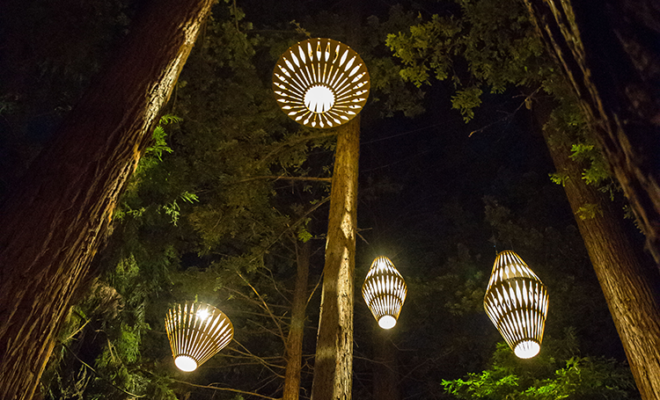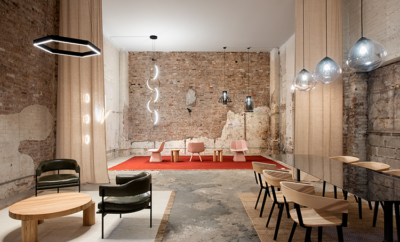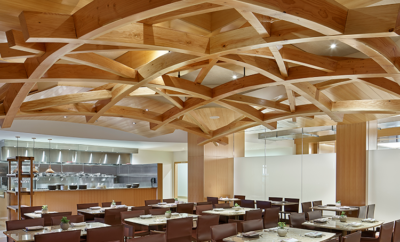 In 2016 Trubridge partnered with Redwoods Treewalk in Rotorua to design a series of nightlights that create a special nocturnal experience for park visitors. COURTESY OF DAVID TRUBRIDGE, BILL HEDGes.
In 2016 Trubridge partnered with Redwoods Treewalk in Rotorua to design a series of nightlights that create a special nocturnal experience for park visitors. COURTESY OF DAVID TRUBRIDGE, BILL HEDGes.
Feature
New Zealand Designer David Trubridge

Courtesy of David Trubridge.
SHUNTED TO THE EDGE OF THE WORLD by the forces of continental drift, New Zealand wasn’t a particularly practical place for Europeans to settle following its 1642 discovery by Dutch explorer Abel Tasman. But the challenge of surviving, let alone importing necessities and producing competitive goods for export, engendered “Kiwi ingenuity”—no, not the flightless native bird’s talent for adapting to an ever-direr existential plight—the pragmatic, DIY ethos of the islanders. Kiwi ingenuity lives on in their maker descendants. “If you want the essence of New Zealand design you’ll find it in craft,” writes Down Under design critic Douglas Lloyd Jenkins. “Designers tend to work in very small runs—and make things themselves.”
That has something to do with the current trade situation. The country lost the incentive to manufacture goods at home after protectionist policies were rolled back in the 1980s, a Turn of events that marked the end of design’s mid-century golden days, when furniture producers such as John Crichton and Garth Chester (inventor of the first cantilevered plywood chair), and industrial designer Gifford Jackson were making their mark on Australasia and the world. But just because the field’s been winnowed doesn’t mean it’s disappeared. The work of the new guard—designers like Carin Wilson, Katy Wallace, Humphrey Ikin, and Jeremy Cole—is certainly worthy, and that of the mid-centurians is much in demand, and can still be had (for a pretty penny) at establishments such as Mr. Bigglesworthy in Auckland. And while New Zealand has lost its share of homegrown talent to the charms of London and New York (which country hasn’t?), it’s made up the difference by luring the likes of Phil Horner and David Trubridge away from the northern hemisphere.

The prototype for the Maru lamp, designed 2018, projects hypnotic layers of shadow when lit. Courtesy of David Trubridge. Bill Hedges photo.
WHEN ASKED ABOUT HIS WORK, David Trubridge brings up a TEDx lecture that his son William, a world-class free diver, delivered in Christchurch in October. “He talk[ed] about diving being almost a metaphor for us in our lives,” Trubridge says. “We have this surface world that we live in, but the deeper you go the more you discover, the more you learn about real things that happened deep down. . . . When you can see down into those still, clear waters you can see a long way and see some amazing stuff lurking down there.”
Trubridge spent ten years sailing around the world before landing in New Zealand, and what he has “seen” in the deep he brought to the surface in the form of polyhedral lattice lighting that calls to mind plankton, brain coral, sea urchins, and shrimp. His material of choice is beige bamboo plywood, which contrasts mightily with the slick glass, metal, and plastic lighting to be found in design showrooms the world round. Everything is made in his all-in-one studio, manufactory, and showroom outside Hastings, and put together by the buyer. It would be terribly uneconomical to ship his creations—some of which measure nearly five feet across—already assembled, so he depends on what he calls the “seed system” to get his lights to customers: kit sets and flat packs. “Why transport one tree in a truck from A to B when you could fill that truck with thousands of seeds?” he asks in a YouTube video that describes his process and philosophy. While he admits that some buyers resent having to put his designs together themselves, he hopes that, for others, a connection to the craft will make their owners cherish the lights all the more.

Trubridge’s Coral pendants with orange finish, 2002, are minimalist expressions of coral’s natural geometry. Courtesy of David Trubridge. Bill Hedges photo.












